“I love deadlines. I like the whooshing sound they make as they fly by.” — Douglas Adams
Playing — and therefore writing about — Magic has been sort of rough for me, lately.
I’ve been on a bit of losing streak — enough so I’ve had to sell off quite a bit of product to stay afloat. Dry runs happen, which is why an established collection or large bankroll is absolutely necessary to staying infinite. It’s a fact of statistics that ‘luck’ (though the term ‘chance’ is more appropriate) is less and less relevant the more iteration occurs. If you flip four coins, the result probably won’t be half heads, half tails; even though that is the most likely of outcomes, it still doesn’t ‘beat the field,’ so to speak. However, if you flip 40 coins, the result will consistently approach 50%, and even more so with a group of 400. A great illustration of this is the game of Blackjack, famous as it is for having some of the best odds against the house of any casino game (about 0.5% in favor of the house, with a neutral deck). There are people who devote large amounts of time and energy to observing tables and making intelligent bets based on those observations. This may seem familiar (incidentally, plus eighteen is a ridiculous count, sort of like rolling three natural twenties). What you might have missed is that in order to determine the odds of an outcome, and thus achieve a favorable result, hours and hours of concentration and deliberation are needed. It just isn’t as simple as counting to sixteen in your head over half an hour. In the game of Blackjack, professional card counters put in so much time and effort that a 1% advantage over the house turns into a solid day’s work. Sure, in Magic, sometimes you split a Top 8 Sealed for 35 packs and never look back, but maintaining “infinite” status on MTGO — which is to say, overall profit — is all about the long haul.
At the time I played this Draft, I hadn’t made it to the finals in the previous past dozen or so. I burned through roughly 200-250 Tix worth of product in a fairly short time. “So, Zonko,” I said to myself, “as a Magic writer who purposes to present himself as competent, if not outrageously skillful, what do you plan to do with a giant, steaming pile of failed drafts?” “Isn’t it obvious?” I replied. “I’ll write about them.”
Draft
Deckbuilding
There aren’t any major decisions to be made here. I decided to exclude Water Servant, as it hardly justifies the steep mana investment by itself. Even though we ostensibly could support it, our deck doesn’t really want what amounts to a very bad Cudgel Troll. Harbor Serpent will be our go-to sideboard option, but our deck doesn’t need a 5/5 wall in the starting line-up; the same goes for Phantom Beasts, which vary in power level according to matchup.
Primal Cocoon is one of those bad cards that can still be rather useful at times. Like Momentum, it creates a steadily growing threat from something that wouldn’t be very relevant otherwise. The difference is that Cocoon effectively phases out the creature it enchants for a few turns, since committing to block early means losing your investment. Still, on a card that isn’t easily removed (Sacred Wolf, anything with high toughness) or on a creature that otherwise wouldn’t be doing much anyway (Sylvan Ranger), or just on a stalled board when no one is attacking, it’s not bad at all. Except, in hindsight, I just like Volcanic Strength better; it’s quicker, wins against Mountains, and, most importantly, makes this a five-color deck. Priorities, people.
I’d like to draw with this deck. While we won’t be terribly upset on the play, the quality of our card selection means we’ll have the advantage in the long game, and our acceleration will allow us to establish board dominance without much trouble. The question you’ve got to ask yourself is, do you expect or want the game to end in a top-deck war, where that extra card might make all the difference? Well, do ya, punk?
Finally, running seventeen lands seems correct for this deck. We’d probably do alright with sixteen, thanks to our Rangers, but the same cards will thin our deck. A single Swamp is all we need, but I included an extra Island in case we’d ever want to cast more than one of our four blue spells in the same turn.
R1G1, choose to draw
This first hand is fine, but our deck can do better; against any but the fastest decks, a Turn 4 Foresee into Turn 5 Fat ThingTM would probably get us there. Nevertheless, with the sheer amount of fixing we’ve got, there’s no need to risk getting flooded just because we’ve got a bunch of different lands. I’d be a little less comfortable throwing this hand away were we on the play, mostly because mulling on the play always sucks (one of the most convincing arguments, to me, for choosing to draw in Limited formats is the flexibility it affords against poor hands), but also because that extra turn would give us the head start to make a slow hand work. Casting Spined Wurm feels a lot better against four lands than five.
Our six is a much, much stronger hand, and a great illustration of why Ranger makes the deck. In occupying an otherwise unused slot (and cheap enough to be inconsequential later on), Strider Jr. (Sylvan Ranger) is basically Evolving Wilds with legs. In M11, a set with a relatively low removal spell count and hardly any of the sweeping variety, a free 1/1 that can get in a few times before chumping is just fine. It took people a while to realize that a 1/1 that generates value is just that. I’m talking about 13th-pick Squadron Hawks when the set was first released.
So, we keep that hand, and are greeted by this:
This would be the first time I’ve seen anyone pull off the mill deck, but pull it off he has. I could write whole articles on mill archetypes, how they always seem to be just beyond the realm of viability. Every so often, Wizards lets it happen — in Kamigawa Block Draft, for example — but the deck usually needs a very specific batch of uncommons and/or rares to make it work. In M11, it isn’t just enough to stack up on Tome Scours and Jaces Erasures. Though those cards are key to the goal of milling, the deck needs to not die first. While casting cards that effectively Do Nothing, the mill player must defend himself and force his opponent into a position where Not Winning really is the same as Losing. I lost the screenshot of his killscreen, but suffice it to say it included two Wall of Frosts and a Master Decoy on his side. Cards like Temple Bell are nice (he had that, too), but those creatures are what won him the game. We lose, and concede instead of showing him the last few cards. (This is one of the more powerful and understated advantages of the mill deck; while the odds of milling away good cards is are exactly the same as milling away the bad cards on top of the good cards, the mill player will have much more information after the first game. If the mill player is playing counters — and he should — he’ll then know exactly when and on what to use them in the next games.) (Also, Gitaxin Probe is good.)
SB: Deathmark is underwhelming here, with only a couple of targets, whereas Harbor Serpent is serpently not.
R1G2, We choose to play — although our deck is more comfortable drawing, we’ll need that extra attack phase and perhaps another the card in the library as well.

Sweet. With any luck at all, we’ll be curving from 2-5cc, and with help from Foresee, we’ll have plenty of gas besides. Keep. The game progresses almost exactly as the first, with him laying down an early Erasure and some defense. Fortunately, that extra bit of curving sweetness gets us there, but only just.
No, your eyes do not deceive you. “z0nk0thesane has won the match.” “Congratulations, Zonko! We’re so happy for you! But, didn’t you lose Game 1?” you might ask, to which I might answer, “Um, yes?” Frankly, I have no idea why this happened. Maybe our opponent hit “concede match” by way of accident. Maybe he had to go. Maybe I’m further advanced in my encroaching senility than the doctors predicted. Who knows?
R2G1, choose to draw.
Our opponent is another fan! I like fans!
This is not a very good hand. It is merely a good hand, and then just barely. With two cards requiring one of five ways of “drawing” a Swamp, a card that may well get Pacifism‘d, no Plains, and a distinct lack of Cultivates, our deck can do far, far better. So, I keep ^^;; Not gonna lie, this is a big part of why the losing streak happened to begin with. Although this hand will most likely do just fine with help from the beast that is Cudgel Troll (it did), keeping here is definitely the Wrong Decision. Games are won by inches, and that decision might have cost me a few feet. (I mean, we knew from scouting that Deathmark would be good against his mostly white team (think the NHL), but we also saw a Pacifism and a Condemn for the Troll.)
Pudgell Roll makes like Banner, and onto Game 2.
Sideboard: He’s playing Mountains, so we’re playing Volcanic Strength, swapping out a Plains for a Mountain of our own.
R2G2, We’re put on the draw.
Well, it’s got four lands of three varieties, plus the Cultivate for the other two. That’s a great hand, right? WRONG. This hand has essentially six lands, meaning any land we draw will be more than we’d like. Crystal Ball will help with this, and Crusader is a nice dude, but if either of those gets taken out, we could be in trouble. As with the previous hand, our deck can easily do better, especially on the draw; and, as with that hand, we make the Wrong Decision to keep.
Fortunately, he doesn’t remove the Ball, and the game progresses to this point:
As you can see, he’s got that cute little combo with the Pride of Mates (Big Love much?), which we will have to Pacify in short order. Most of his other dudes get trumped by Le Troll, as well as any other Fat Ass we can search up. I’m pretty thrilled to find that angel, as she’s pretty much our win condition. Now, if only we had another Plains . . . except, we sort of do. Can you see it? On our turn, after drawing Serra Angel, we make the Wrong Decision and cast Gravedigger to recycle Cloud Crusader as Shaman fodder. This is generally a bad move, since, because we’re just going to discard a creature anyway, the only advantage playing the Gravedigger has over just using it for fodder is a 4cc 2/2. While a ‘free’ bear may be relevant on some boards, it most certainly is not here. Had we made the Correct Decision to use Fauna Shaman on our turn, after having drawn the Angel, to search for a Sylvan Ranger, to search a Plains, we would have the same chump blocker (albeit a 1/1 instead of a 2/2) for 1 mana less, and the Angel in play. Of course, the downside to that line of play is that it leaves us without mana for Cudgel Troll and or Crystal Ball, giving our opponent a rare opportunity to attack; still, he’d need another spell or two to help him out for it to be profitable.
But we didn’t do that. We cast Gravedigger, and passed into this:
That Treacherous Wurm! Too late, I activate the Shaman . . . or is it? If a grab a Ranger now, fetching a Plains, I’ll have four blockers to his five available attackers, of which two just get eaten by my board. If he can’t break through with another alpha, I’ll be able to cast Pacifism on his other Mate, and Scry ‘n FlyTM my way to victory!
Instead, I fetch an Azure Drake. Lacking that crucial point of power, much like a teen with low self esteem, the Drake fails to forestall his advances and we get utterly f***ed.
R2G3, Choose to play — this was a mistake.
Agitated by my earlier errors, I became more belligerent. My thinking was to gain the upper hand/wing in a racing situation, before his Pridemates and Large Things got too out of hand. This argument, however, doesn’t hold up to my reasons for drawing. But really? It’s not a terrible plan at all. Sure, it’s crazy — so crazy, it just might work. The problem here is far more the why than the what. For me, this was an emotional decision, informed by earlier poor choices. We have a term for that: being on tilt.
This hand is alright. We’ll need to get lucky with drawing, but Diminish and Drake are the stuff that will get us there. We’ll leave the Swamp for later fixing, as the ‘Digger just gets better as the game goes on. We hope to draw a couple more fliers to win in the air, which makes the endgame just a tad ironic:
That’s it. We lost.
Conclusion:
Losing sucks. It really, really does. As a mature player, I like to remind myself (but not others — maturity that without losing, winning loses meaning. All you can do is take it in stride, accept the loss and say “Good game.”
But it still sucks.
Okay, maybe we should talk about this. I lost; people lose. What now? Well, let’s work this out. First, how am I feeling afterward? If I played a great game that I just happen to have lost, I usually want to Draft again. Who wants to give up a Magic high? However, unless you’re a student on break with easy access to prescription drugs (move along), you’ve probably got responsibilities, or at the very least a powerful need to eat sometime this month. As a rule, I don’t draft more than three times in a row regardless or outcome, and even then I’ll walk away from the computer if an unexpected obligation crops up. There’s no point playing a game at the expense of a healthy, (somewhat) productive life.
It’s just a game. As a mature player, I know and acknowledge that. Still, after two unsatisfying Drafts in a row, I’m a bit frustrated. I feel like “rage-Drafting,” with the fantasy that I’ll rip packs like a beast and sweep the field. In case any of you were wondering, fantasy isn’t exactly a solid base for critical decision-making. Instead of actually thinking things through, I’m at this point following my emotions of frustration. This is called tilting, and it’s precisely the thing you want to avoid.
The most important step is to become self-aware. You need to be able to evaluate your mental state. Are you very tired? Have you been drinking? Is there an emotional stressor in your life? Ask yourself these questions; if any of them get a ‘yes,’ then you can’t expect to perform as well as you might with a level head. For this reason, drafting Magic makes for less of an effective stress relief than other, less performance-intensive hobbies.
Take a nap or a shower. Grab something to eat. Maybe listen to music, or take a walk. Magic is a high-stress activity (I’m having the most fun when I’m literally shaking with nerves and adrenaline — drafting does that to me sometimes), so it’s absolutely essential to relax elsewhere. All of those activities are proven to have a positive and rejuvenating effect. You’ll feel — and play — better when you’re done.
Perspective can also help mute the emotional impact of losing games. If you don’t let Magic become the greater part of your life (always a danger during breaks), losing just won’t mean as much, and you’ll be able to accept that more easily. Decide to set a pace, limiting yourself to a certain number of events or hours of play per day or week. It’s like only taking cash to the casino; if you can only lose what you have on you, well, you can only lose that much.
If you can mitigate the emotional influence in your decisions, you’ll not only find yourself winning more, you’ll have more fun while playing. Winning becomes a chore if the game itself isn’t enjoyable. Any player who feels like dropping after a Round 1 loss in a Swiss event should really consider why they chose to commit their time in the first place. After all, the only real profit from winning is just more time playing Magic. This slot machine only pays out in free replays.
Magic is just a game. That’s what I say to myself after a few losses, as I look outside and smile.


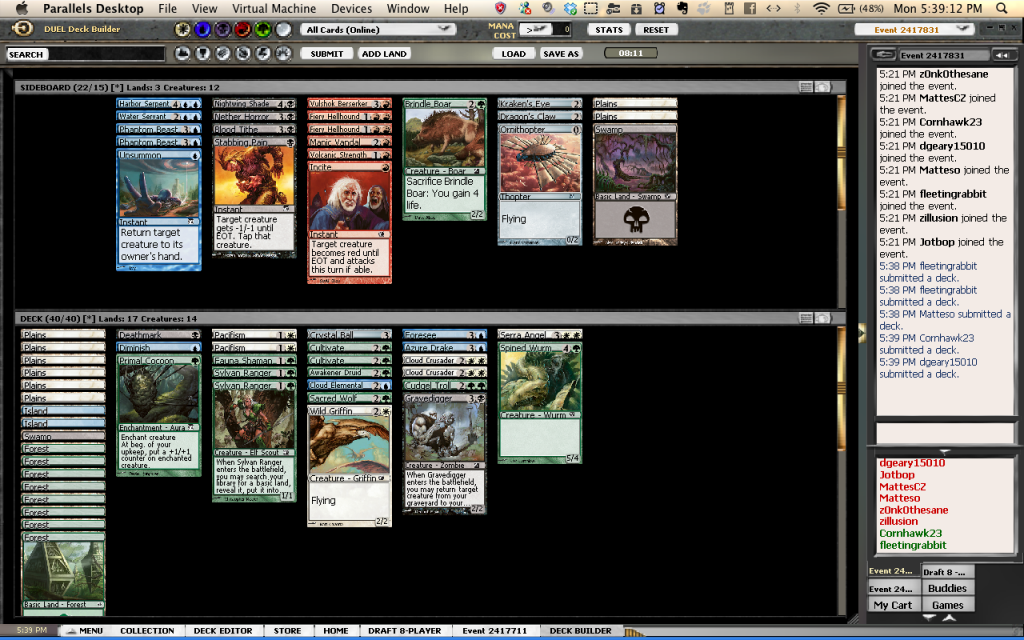



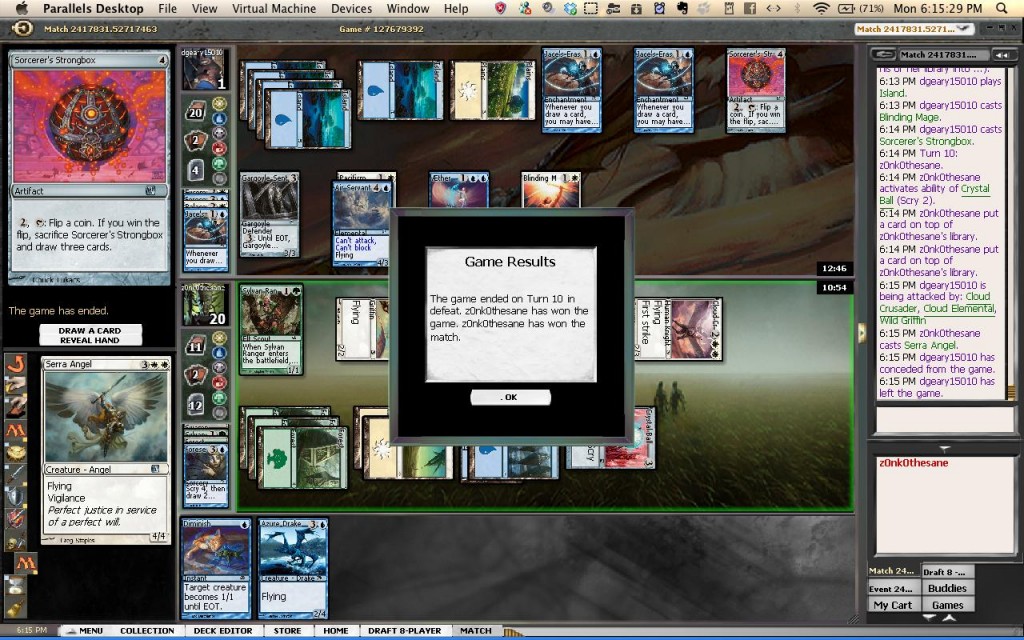


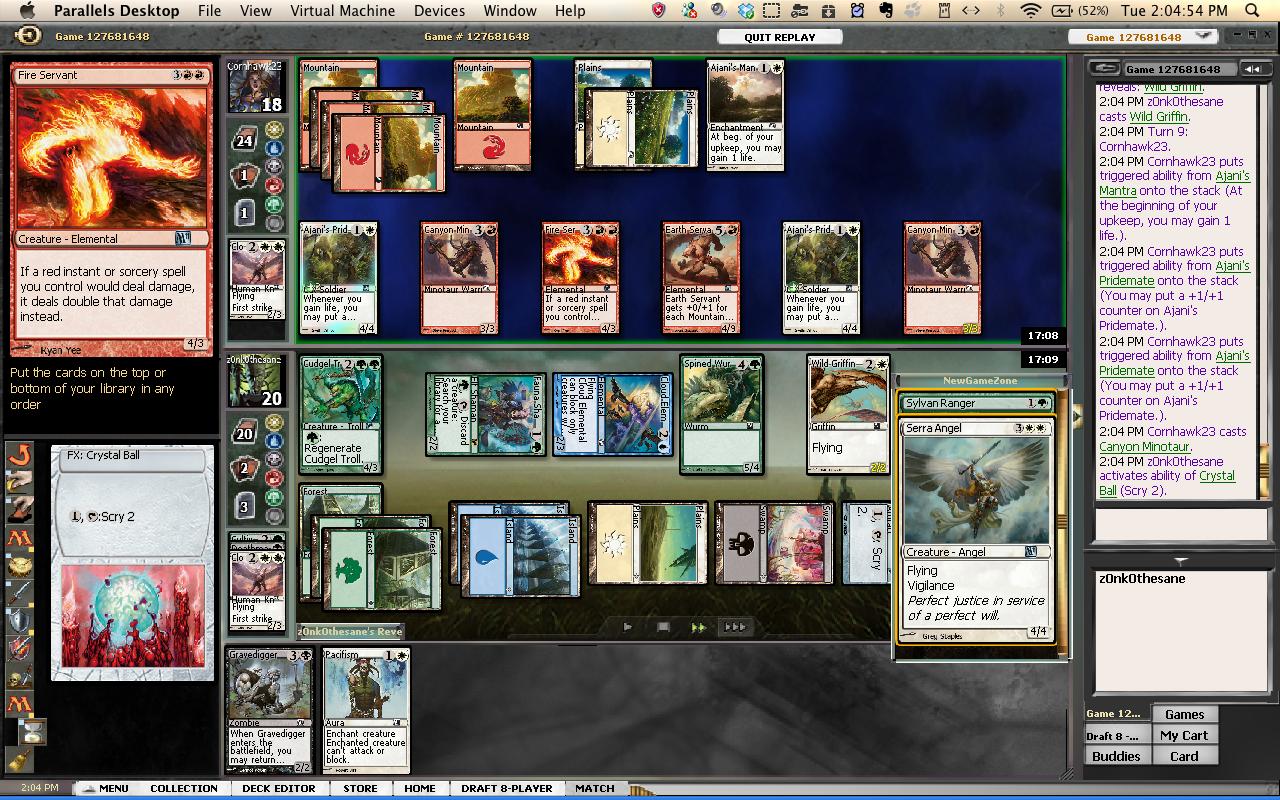
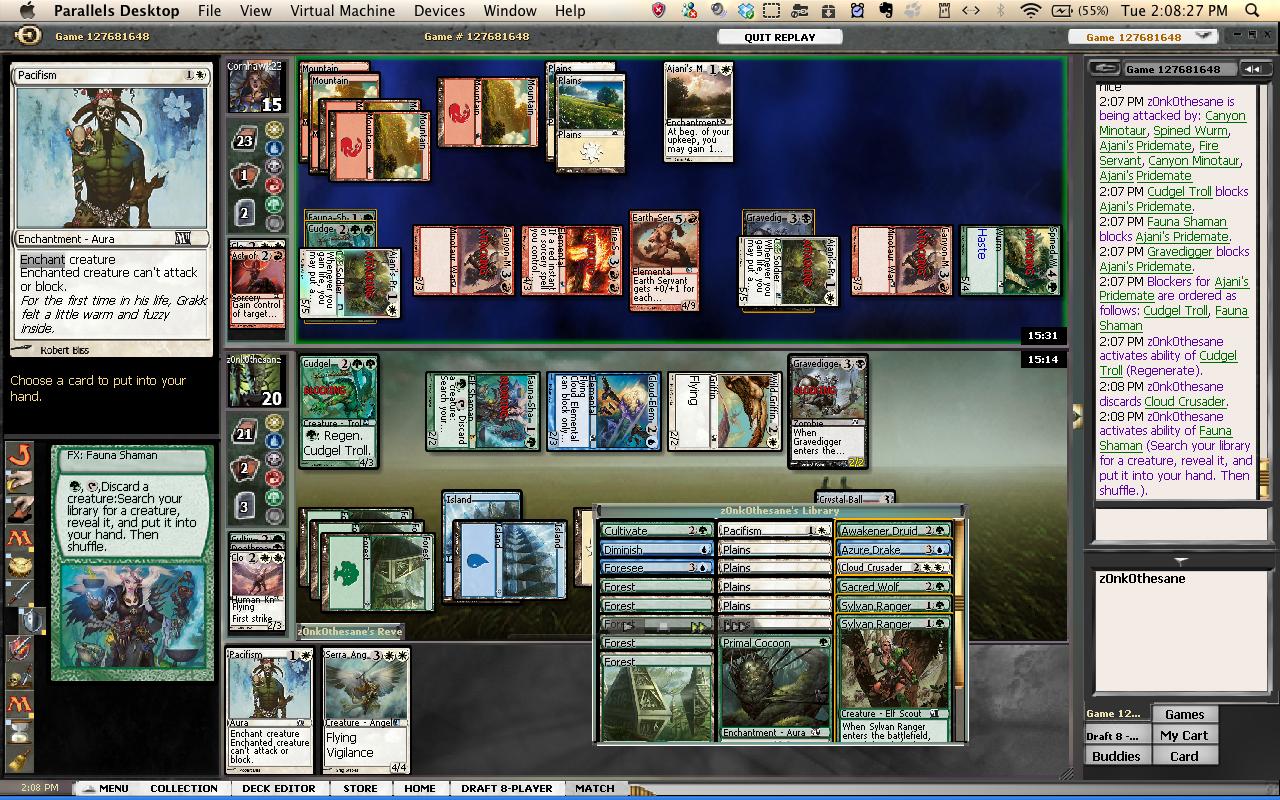

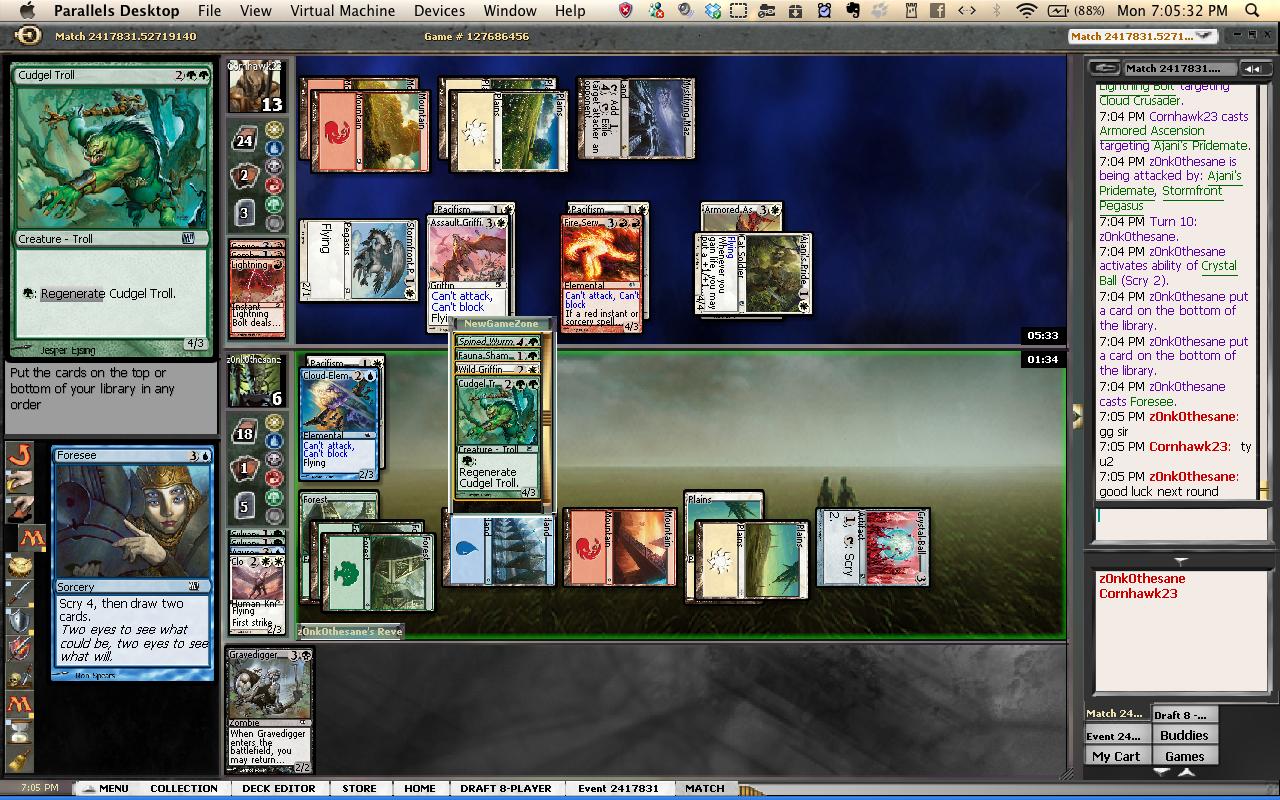
I don’t think you should mulligan good hands just because your deck can do better. Sure it can, but can do worse as well. It is entirely possible that you mulligan into a 1-land hand, and then your 5 card will never be better than your starting seven in any of these games.
great article, zonko. write some more, please…
@milegy
Of course my deck could do worse as well as better. The question is, which is more likely? Or, to be more accurate, will mulliganing be likely to produce a more capable hand than simply keeping? In the case of R1G1, I believe the risk of drawing an undesirably quantity of mana sources (which are, in a way, dead cards) outweighed the possibility of producing a lesser quality hand, even after the second mulligan.
Some decks do mulligan better than others. That is an inherent advantage to any build that wants to draw first, as mine did. As you can see, that particular deck was also quite comfortable with two-land hands, as long as one of those lands was a Forest. To contrast, most other multi-color decks require a specific mix of mana sources to function, and thus simply can’t afford to throw away even poor hands if they contain three kinds of lands. I didn’t have that restriction.